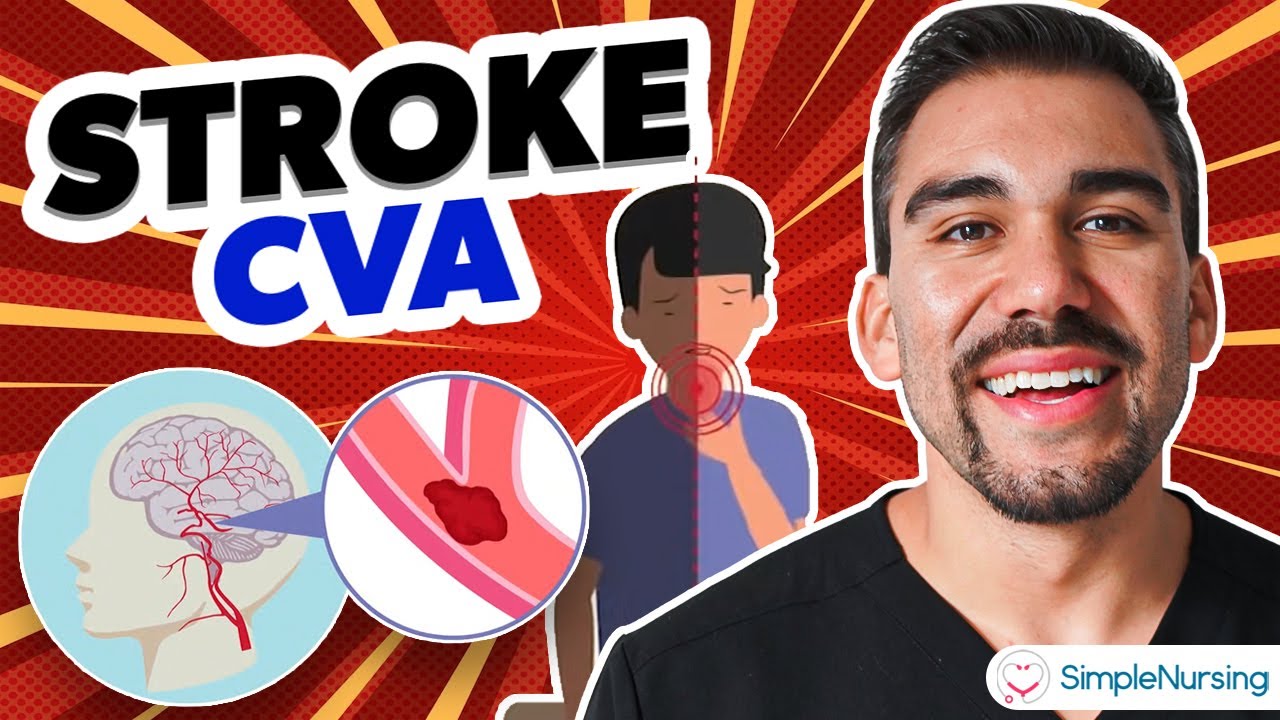STROKE Lengkap - Klasifikasi, Patofisiologi, Skor Siriraj, Gajah Mada, Latihan Soal UKMPPD
Summary
TLDRThis video discusses stroke, focusing on its classification into ischemic and hemorrhagic types. It explains the causes of stroke, such as arterial blockages or ruptured blood vessels, and how these lead to reduced blood flow to the brain. The video further explores diagnostic methods, risk factors, clinical manifestations, and how to differentiate between ischemic and hemorrhagic strokes. Additionally, it covers stroke's pathophysiology, potential complications, and emergency management, including the ABCD approach. The content also provides insights on the use of scoring systems for assessing stroke severity.
Takeaways
- 😀 Stroke is a syndrome characterized by sudden neurological deficits due to vascular factors.
- 😀 There are two types of stroke: ischemic stroke, caused by blockages in arteries leading to the brain, and hemorrhagic stroke, caused by bleeding in the brain.
- 😀 Ischemic stroke occurs when blood flow to the brain is blocked by a thrombus (clot) or embolus (floating debris).
- 😀 Hemorrhagic stroke occurs when an artery in the brain ruptures, leading to blood loss and reduced oxygen supply to the brain.
- 😀 A transient ischemic attack (TIA) is a brief, temporary ischemic stroke that resolves in less than 24 hours.
- 😀 Risk factors for ischemic stroke include diabetes, obesity, dyslipidemia, and cardiovascular conditions like atrial fibrillation.
- 😀 Hemorrhagic stroke is commonly caused by hypertension, aneurysms, and bleeding disorders.
- 😀 Stroke can cause neurological deficits such as hemiparesis (weakness on one side of the body) and other cognitive or sensory impairments.
- 😀 The diagnosis of stroke can be determined by evaluating symptoms like consciousness level, headache, and reflexes, alongside imaging and scoring tools.
- 😀 For ischemic stroke, treatment includes addressing the blockage, while hemorrhagic stroke may require surgery or interventions to stop the bleeding.
Q & A
What are the two main types of stroke discussed in the script?
-The two main types of stroke discussed are ischemic stroke and hemorrhagic stroke. Ischemic stroke is caused by a blockage or narrowing of arteries leading to the brain, while hemorrhagic stroke occurs due to bleeding in the brain from a ruptured blood vessel.
What is the key difference between ischemic stroke and transient ischemic attack (TIA)?
-The key difference is that ischemic stroke causes neurological deficits that last longer than 24 hours, whereas a transient ischemic attack (TIA) causes temporary symptoms that resolve within 24 hours.
What are common causes of ischemic stroke?
-Ischemic stroke is typically caused by thrombus (blood clots) or embolus (a blockage that travels from another part of the body, often the heart), as well as conditions like hypoxia, hypotension, or shock.
How does hemorrhagic stroke differ in its pathophysiology from ischemic stroke?
-Hemorrhagic stroke occurs when a blood vessel in the brain ruptures, leading to bleeding and reduced blood supply to the brain. This contrasts with ischemic stroke, where blood supply is reduced due to blockage or narrowing of arteries.
What are some risk factors for ischemic stroke?
-Risk factors for ischemic stroke include diabetes mellitus, obesity, dyslipidemia, cardiovascular diseases (such as atrial fibrillation), and smoking.
What are the clinical manifestations of a stroke?
-Common clinical manifestations of stroke include sudden weakness or numbness in the limbs, difficulty speaking, visual disturbances, and loss of consciousness. The symptoms typically affect one side of the body.
What diagnostic methods are used to differentiate between ischemic and hemorrhagic stroke?
-Diagnostic methods include imaging techniques such as CT scans or MRIs, along with clinical scoring systems like the Gajah Mada Algorithm and Siriraj Score, which assess factors such as consciousness, headache, vomiting, and blood pressure.
What is the Siriraj Score and how is it used in stroke diagnosis?
-The Siriraj Score is a diagnostic tool used to assess the likelihood of a stroke being hemorrhagic or ischemic. It evaluates factors like consciousness, vomiting, blood pressure, and medical history. A score above 1 suggests hemorrhagic stroke, while below -1 indicates ischemic stroke.
What are the immediate treatments for stroke?
-Immediate treatment for stroke follows the ABCD protocol: ensuring the airway is clear, controlling breathing, and stabilizing circulation. In ischemic stroke, treatments may include thrombolysis or thrombectomy, while hemorrhagic stroke may require surgery to control bleeding.
What are some complications that can occur due to stroke?
-Complications of stroke can include brain edema (swelling), increased intracranial pressure, seizures, respiratory problems, cardiac issues, and even death if not treated promptly.
Outlines

This section is available to paid users only. Please upgrade to access this part.
Upgrade NowMindmap

This section is available to paid users only. Please upgrade to access this part.
Upgrade NowKeywords

This section is available to paid users only. Please upgrade to access this part.
Upgrade NowHighlights

This section is available to paid users only. Please upgrade to access this part.
Upgrade NowTranscripts

This section is available to paid users only. Please upgrade to access this part.
Upgrade NowBrowse More Related Video

Stroke CVA (Cerebrovascular Accident) Hemorrhagic, Ischemic NCLEX RN & LPN NURSING

Overview of Ischemic and Hemorrhagic Stroke | Clinical Neurology

What Causes a Stroke?

AVC DO PIRULLA: o que REALMENTE ACONTECEU e COMO EVITAR

Brain Stroke, Types of, Causes, Pathology, Symptoms, Treatment and Prevention, Animation.

Ischemic Stroke - causes, symptoms, diagnosis, treatment, pathology
5.0 / 5 (0 votes)